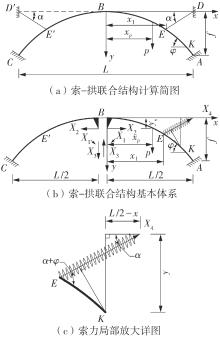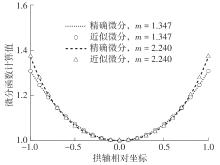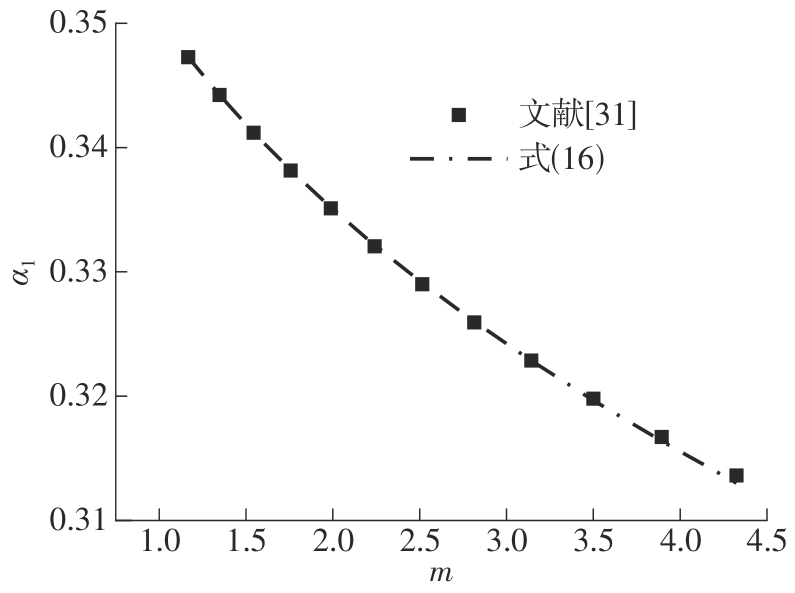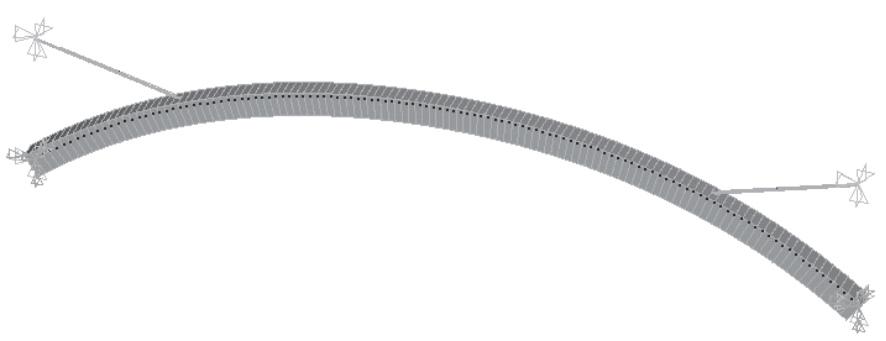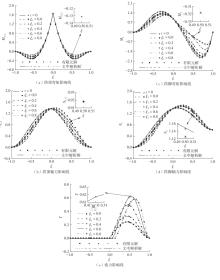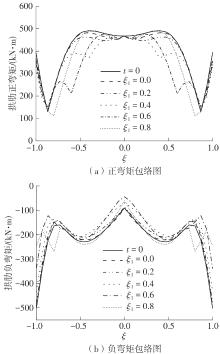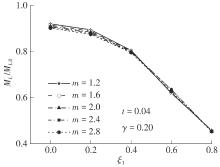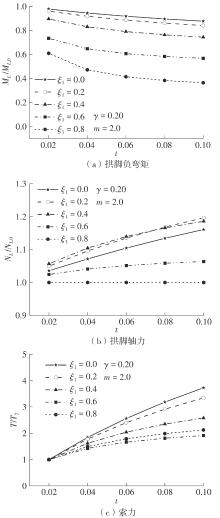Journal of South China University of Technology(Natural Science Edition) ›› 2024, Vol. 52 ›› Issue (8): 89-102.doi: 10.12141/j.issn.1000-565X.230566
Special Issue: 2024年土木建筑工程
• Architecture & Civil Engineering • Previous Articles Next Articles
Mechanism and Mechanical Characteristics of Cable-Catenary Arch Combined Structure
HAO Tianzhi1,2 LI Chunhua1 YANG Tao1 LONG Xiayi2 DENG Nianchun1
- 1.School of Civil Engineering and Architecture,Guangxi University,Nanning 530004,Guangxi,China
2.Guangxi Beitou Transportation Maintenance Technology Group Co. ,Ltd. ,Nanning 530022,Guangxi,China
-
Received:2023-09-11Online:2024-08-25Published:2024-03-14 -
Contact:杨涛(1979 —),男,博士,副教授,主要从事组合结构受力性能研究。 E-mail:yangt@gxu.edu.cn -
About author:郝天之(1980 —),男,博士,正高级工程师、研究员,主要从事桥梁检(监)测、评估及维修加固研究。E-mail: htz0537@163.com -
Supported by:the Science & Technology Base and Talent Project of Guangxi(AD23026026);the Natural Science Foundation of Guangxi(2023GXNSFAA026427)
CLC Number:
Cite this article
HAO Tianzhi, LI Chunhua, YANG Tao, et al. Mechanism and Mechanical Characteristics of Cable-Catenary Arch Combined Structure[J]. Journal of South China University of Technology(Natural Science Edition), 2024, 52(8): 89-102.
share this article
Table 3
Comparison of internal forces in the key sections of catenary arch and cable-arch combined structures at different rise-span ratios"
| 算例 | 关键截面内力 | ξ | 悬链线拱 | 索-拱联合结构 | ||||
|---|---|---|---|---|---|---|---|---|
| 文中解析解 | 有限元解 | 相对误差/% | 文中解析解 | 有限元解 | 相对误差/% | |||
| 算例1(f /L=1/5) | M/(N·m) | 0.0 | -0.305 | -0.305 | 0.000 | -0.111 | -0.111 | 0.000 |
| 1.0 | -1.312 | -1.316 | 0.304 | -0.178 | -0.182 | 2.198 | ||
| N/N | 0.0 | 0.673 | 0.674 | 0.149 | 0.395 | 0.395 | 0.000 | |
| 1.0 | 1.059 | 1.065 | 0.563 | 1.189 | 1.199 | 0.834 | ||
| 算例2(f /L=1/6) | M/(N·m) | 0.0 | -0.291 | -0.291 | 0.000 | -0.131 | -0.131 | 0.000 |
| 1.0 | -1.369 | -1.372 | 0.219 | -0.382 | -0.385 | 0.779 | ||
| N/N | 0.0 | 0.799 | 0.799 | 0.000 | 0.517 | 0.518 | 0.193 | |
| 1.0 | 1.143 | 1.147 | 0.349 | 1.320 | 1.327 | 0.528 | ||
| 算例3(f /L=1/7) | M/(N·m) | 0.0 | -0.275 | -0.275 | 0.000 | -0.144 | -0.144 | 0.000 |
| 1.0 | -1.421 | -1.424 | 0.211 | -0.566 | -0.568 | 0.352 | ||
| N/N | 0.0 | 0.921 | 0.921 | 0.000 | 0.644 | 0.644 | 0.000 | |
| 1.0 | 1.225 | 1.226 | 0.082 | 1.441 | 1.443 | 0.139 | ||
| 1 | 陈少林,伍锐,张娇,等 .地形和土-结相互作用效应对三维跨峡谷桥梁地震响应的影响分析[J].力学学报,2021,53(6):1781-1794. |
| CHEN Shaolin, WU Rui, ZHANG Jiao,et al .Topo-graphy and soil-structer interaction effects on the seismic response of three dimensional canyon-crossing bridge [J].Chinese Journal of Theoretical and Applied Mechanics,2021,53(6):1781-1794. | |
| 2 | 谢肖礼,勾文鑫,庞木林,等 .RC刚架拱桥的板桁组合加固及动力特性[J].华南理工大学学报(自然科学版),2023,51(4):31-43. |
| XIE Xiaoli, GOU Wenxin, PANG Mulin,et al .Dynamic characteristics of RC rigid frame arch bridge strengthened by plate-truss combination[J].Journal of South China University of Technology (Natural Science Edition),2023,51(4):31-43. | |
| 3 | 陈旭勇,胡海棠,高兵勇 .非概率可靠性在拱桥评估与加固中的应用[J].桥梁建设,2016,46(2):60-64. |
| CHEN Xu-yong, HU Hai-tang, GAO Bing-yong .Application of non-probabilistic reliability theory to assessment and reinforcement of arch bridges[J].Bridge Construction,2016,46(2):60-64. | |
| 4 | 陈增顺,周建庭,张承,等 .体外预应力加固钢筋混凝土拱桥关键技术研究[J].重庆交通大学学报(自然科学版),2013,32(Sup1):823-826. |
| CHEN Zengshun, ZHOU Jianting, ZHANG Cheng,et al .Key technology of external prestressing reinforced concrete arch bridge[J].Journal of Chongqing Jiaotong University (Natural Science),2013,32(Sup 1):823-826. | |
| 5 | SHAO X D, HE G, SHEN X J,et al .Conceptual design of 1000 m scale steel-UHPFRC composite truss arch bridge [J].Engineering Structures,2021,226:111430/1-12. |
| 6 | WANG Z S, YANG J, ZHOU J T,et al .Strengthening of existing stone arch bridges using UHPC:theoretical analysis and case study[J].Structures,2022,43:805-821. |
| 7 | 王宗山,周建庭,杨俊,等. UHPC在圬工拱桥加固中的应用[J].世界桥梁,2022,50(2):105-111. |
| WANG Zong-shan, ZHOU Jian-ting, YANG Jun,et al .Application of UHPC to reinforcement masonry arch bridges[J].World Bridge,2022,50(2):105-111. | |
| 8 | YANG J, CHEN R, ZHANG Z Y,et al .Experimental study on the ultimate bearing capacity of damaged RC arches strengthened with ultra-high performance concrete [J].Engineering Structures,2023,279:115611/1-13. |
| 9 | VARRO R, BÖGÖLY G, GÖRÖG P .Laboratory and numerical analysis of failure of stone masonry arches with and without reinforcement[J].Engineering Failure Analysis,2021,123:105272/1-10. |
| 10 | XIE X Q, CHEN Z F, GUO S S .Bridge bearing capacity test and the application research carbon fiber reinforcement technology[J].Advanced Materials Research. 2015,1065:860-864. |
| 11 | 马兴林,杨俊,周建庭,等 .UHPC与石材的粘结界面抗剪性能试验研究[J].材料导报,2022,36(24):21070133/1-7. |
| MA Xinglin, YANG Jun, ZHOU Jianting,et al .Experimental study on shear properties of UHPC and stone[J].Materials Reports,2022,36(24):21070133/1-7. | |
| 12 | 陈磊,丁鹏,周建庭,等 .基于UHPC套箍与预应力相结合的肋拱桥加固技术研究[J].混凝土,2019,362(12):173-176. |
| CHEN Lei, DING Peng, ZHOU Jianting,et al .Research on reinforcement technology of ribbed arch bridge based on UHPC hoop and prestress[J].Concrete,2019,362(12):173-176. | |
| 13 | 彭凯,乔奋义,贾小飞 .预应力折线形铰接钢拱加固拱桥技术试验研究[J].重庆交通大学学报(自然科学版),2017,36(4):12-17. |
| PENG Kai, QIAO Fenyi, JIA Xiaofei .Strengthening technique of prestressing hinged piecewise steel arches for arch bridges[J].Journal of Chongqing Jiaotong University (Natural Science),2017,36(4):12-17. | |
| 14 | 何劲,徐温,宋丹青,等 .FBG自感知预应力碳纤维板在桥梁加固中的应用[J].公路,2023(1):129-134. |
| HE Jin, XU Wen, SONG Dan-qing,et al .Research on the application of FBG self-sensing prestressed carbon fiber plates in bridge strengthening[J].Highway,2023(1):129-134. | |
| 15 | KAREEM M M, YASER A A .Experimental investigation on the transform the simply supported girders to continuous girder by using the UHPC cast in place joint [J].KSCE Journal of Civil Engineering,2023,27(4):1697-1707. |
| 16 | QIN X, PANG M L, XIE X L,et al .A new deck arch bridge and a study on its mechanical properties by FE and experiment methods[J].Advances in Structural Engineering,2022,25(1):63-82. |
| 17 | ZAMPIERI P, PIAZZON R, FERRONI R,et al .The application of external post-tensioning system to a damage masonry arch[J].Procedia Structural Inte-grity,2023,44:605-609. |
| 18 | 陈齐风,徐赵东,郝天之,等 .设置反拱加固的拱结构力学性能研究[J].应用力学学报,2020,37(2):666-673. |
| CHEN Qifeng, XU Zhaodong, HAO Tianzhi,et al .Mechanical performance of arch structure with anti arch reinforcement[J].Chinese Journal of Applied Mechanics,2020,37(2):666-673. | |
| 19 | 董越,霍文营,孙海林 .中铁青岛世界博览城展廊屋盖索拱结构设计[J].建筑结构,2022,52(1):12-16. |
| DONG Yue, HUO Wenying, SUN Hailin .Structural system design of cable arch structure on exhibition gallery roof of China Railway Qingdao World Expo City [J].Building Structure,2022,52(1):12-16. | |
| 20 | 康厚军 .索拱结构的稳定与振动研究[D].长沙:湖南大学,2007. |
| 21 | 刘利,康厚军,苏潇阳,等 .拱暨索拱面内稳定性研究的传递矩阵法[J].计算力学学报,2020,37(1):98-107. |
| LIU Li, KANG Hou-jun, SU Xiao-yang,et al .Transfer matrix method for studying the in-plane stability of arch and cable-arch[J].Chinese Journal of Computational Mechanics,2020,37(1):98-107. | |
| 22 | 刘迎春,薛素铎,李雄彦,等 .上承式拉索组合拱桥动力特性研究[J].公路,2013(5):15-19. |
| LIU Ying-chun, XUE Su-duo, LI Xiong-yan,et al .Study on dynamic characteristics of deck type arch bridge with diagonal cables[J].Highway,2013(5):15-19. | |
| 23 | 李双蓓,梁睿,梅国雄 .考虑弹性压缩的弹性支承抛物线拱内力解析解[J].工程力学,2023,40(11):1-10. |
| LI Shuang-bei, LIANG Rui, MEI Guo-xiong. Analytical solution of internal force of parabolic arch with elastic supports considering elastic compression[J].Engineering Mechanics,2023,40(11):1-10. | |
| 24 | KANG H J, ZHAO Y Y, ZHU H P .Analytical and experimental dynamic behavior of a new type of cable-arch bridge[J].Journal of Constructional Steel Research,2014,101:385-394. |
| 25 | KANG H J, ZHAO Y Y, ZHU H P .Stability of cable-arch structure[J].Applied Mechanics and Materials,2012,204/205/206/207/208:3061-3067. |
| 26 | 周宇,许成超,赵青,等 .变截面悬链线无铰拱应变影响线的解析解[J].计算力学学报,2022,39(5):551-556. |
| ZHOU Yu, XU Cheng-chao, ZHAO Qing,et al .Practical analytical expression to strain influence line of varying cross section catenary fixed arch[J].Chinese Journal of Computational Mechanics,2022,39(5):551-556. | |
| 27 | 胡常福,陆小雨,甘慧慧,等 .基于近似积分的悬链线拱实用解析解[J].中南大学学报(自然科学版),2015,46(3):1058-1065 |
| HU Changfu, LU Xiaoyu, GAN Huihui,et al .Practical analytical solution of catenary arch based on approximate integration method[J].Journal of Central South University (Science and Technology),2015,46(3):1058-1065. | |
| 28 | 胡常福,何兵兵,石萃佳,等 .复杂轴线拱结构实用解析解研究[J].中南大学学报(自然科学版),2018,49(1):217-225. |
| HU Changfu, HE Bingbing, SHI Cuijia,et al .Research on approximate analytical solution of arch structure with complex arch axis[J].Journal of Central South University (Science and Technology),2018,49(1):217-225. | |
| 29 | 程红光 .实腹式圬工拱桥简化计算图式研究[D].武汉:华中科技大学,2011. |
| 30 | WANG J, MELBOURNE C .Mechanics of MEXE method for masonry arch bridge assessment[J].Proceedings of the Institution of Civil Engineers-Engineering and Computational Mechanics,2010,163(3):187-202. |
| 31 | 顾懋清,石绍甫 .公路桥涵设计手册——拱桥(上册)[M].北京:人民交通出版社,1994. |
| 32 | 徐福旺,胡清,袁长春,等 .钢管混凝土悬链线深拱单点加载试验研究[J].建筑结构学报,2021,42(S2):373-381. |
| XU Fuwang, HU Qing, YUAN Changchun,et al .Experimental investigation on concrete-filled steel tubular catenary arches under single-point concentrated load [J].Journal of Building Structures,2021,42(S2):373-381. | |
| 33 | 侯春辉,宋顺心 .基于APDL语言的拱轴线优化及立柱布置研究[J].铁道工程学报,2017,34(10):55-59. |
| HOU Chun-hui, SONG Shun-xin .Research on the optimization of arch-axis and column layout based on APDL language[J].Journal of Railway Engineering Society,2017,34(10):55-59. | |
| 34 | 叶伟,王雷,孙向东,等 .中承式钢管混凝土拱桥拱肋关键参数影响分析[J].桥梁建设,2023,53(3):79-86. |
| YE Wei, WANG Lei, SUN Xiang-dong,et al .Key parameter influence analysis of half-through concrete-filled steel tubular arch bridge[J].Bridge Construction,2023,53(3):79-86. |
| [1] | YU Jun, ZHENG Jingfan, ZHANG Zhizhong, et al. Analytical Solution and Simplified Solution of Two-Dimensional Steady Seepage Field in Foundation Pit [J]. Journal of South China University of Technology(Natural Science Edition), 2024, 52(5): 84-91. |
| [2] | CHEN Yanfeng, CHEN Sheng, ZHANG Bo, et al. Analysis of Transient and Steady-State Characteristics of Fractional-Order Cuk Converter [J]. Journal of South China University of Technology(Natural Science Edition), 2023, 51(3): 1-12. |
| [3] | LU Aizhong LI Zhiyu. Analytical Solution of Steady-State Temperature Field in the Plane Double Connected Domain [J]. Journal of South China University of Technology(Natural Science Edition), 2019, 47(9): 9-17. |
| [4] | ZHANG Yong-qiang. Theoretical Analysis and Numerical Simulation of Large-Diameter and Thin-Wall Pipelines During Ultra-Deep J-Lay Installation [J]. Journal of South China University of Technology (Natural Science Edition), 2017, 45(8): 126-131. |
| [5] | WEI De-min TU Jia-ming. A Probe into Nonlinear Stability of Single-Layer Reticulated Shells by Means of Random Imperfection Modal Method [J]. Journal of South China University of Technology (Natural Science Edition), 2016, 44(7): 83-89. |
| [6] | Han Qiang Wang Zhi-gang Zhang Yong-qiang Tao Xu. Singular Perturbation Analysis of Large-Diameter and Thin-Wall Pipeline During Ultra-Deep S-lay Installation [J]. Journal of South China University of Technology (Natural Science Edition), 2015, 43(6): 116-121. |
| [7] | Zhang Ai-jun Mo Hai-hong Zhu Zhen-de. Analytical Method of Elasto-Plastic Subgrade Reaction for Single Pile Subjected to Lateral Soil Movement [J]. Journal of South China University of Technology(Natural Science Edition), 2012, 40(9): 153-159. |
| [8] | Yang Yi Liu Ji-ke. Precision Analysis of Classical Bending Deflection Formulae of Simply-Supported Beams [J]. Journal of South China University of Technology (Natural Science Edition), 2008, 36(6): 30-34. |
| [9] | Wang Chao Zhang Yao Xia Cheng-jun Liu Yong-qiang . Determination of Attraction Region of High-Dimension System Based on Analytical Solution to Unstable Limit Cycle [J]. Journal of South China University of Technology (Natural Science Edition), 2008, 36(6): 133-137. |
| Viewed | ||||||
|
Full text |
|
|||||
|
Abstract |
|
|||||
